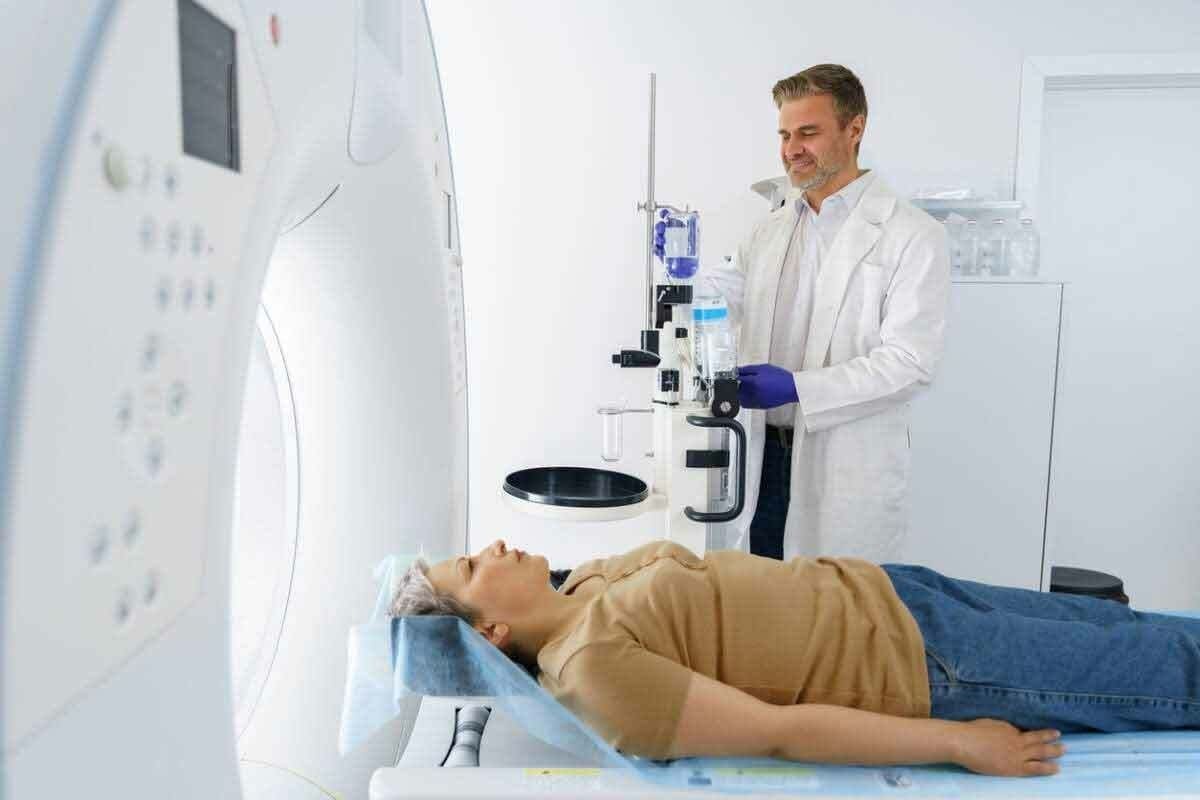Last Updated on November 27, 2025 by Bilal Hasdemir

At Liv Hospital, we use advanced imaging technology to diagnose and treat complex medical conditions. For detecting brain tumors, CT scans are one of our key tools, offering rapid and accurate results. Patients often ask, can a CT scan detect brain cancer? The answer is yes”CT scans use X-rays to create detailed brain images, allowing us to spot larger or denser tumors such as gliomas and meningiomas.
They are particularly valuable in emergency cases requiring swift diagnosis. While MRI is typically more sensitive for identifying small or low-density tumors, CT scans remain essential for initial assessment and urgent care. By combining both methods when necessary, we ensure that our patients receive precise diagnoses and top-quality treatment. better for small or light tumors. Yet, CT scans are a big part of our toolkit. They help us give top-notch care to our patients.
Key Takeaways
- CT scans use X-ray technology to produce detailed images of the brain.
- They are useful in detecting various types of brain tumors.
- CT scans are very helpful in emergency situations.
- Small or low-contrast tumors may be better seen with MRI.
Understanding CT Scan Technology
CT scan technology is key for diagnosing and treating medical conditions, like brain tumors.
What is a CT Scan?
A CT scan, or Computed Tomography scan, uses X-rays from different angles to create detailed images. It shows the body’s internal structures clearly. This is vital for spotting tumors and other issues.
How X-ray Technology Creates Cross-Sectional Images
CT scans use X-rays to see inside the body. As the X-ray tube moves, it sends X-rays through the body. Sensors detect these X-rays, and a computer turns them into detailed images.
In brain imaging, this tech helps find tumors and other problems with great accuracy.
Types of CT Scans Used for Brain Imaging
There are different CT scans for brain imaging, each for a specific use. Noncontrast CT is used in emergencies to check for bleeding or fractures. Contrast-enhanced CT uses a dye to show blood vessels or tumors more clearly. CT angiography focuses on the brain’s blood vessels.
At Liv Hospital, we use these CT scans to give our patients the best care. Knowing how each scan works helps us make accurate diagnoses and treatment plans.
The Process of Brain Tumor Detection Through CT Scans

Using CT scans to find brain tumors is a detailed process. It starts with getting ready for the scan.
Preparation for a Brain CT Scan
Getting ready for a CT scan is important. Patients usually take off metal items like jewelry or glasses. This is to avoid any problems during the scan.
Depending on the scan type, patients might need to not eat for a few hours. They might also get a special dye to help see certain parts better.
Key preparation steps include:
- Removing metal objects
- Fasting (if required)
- Administering contrast agent (if necessary)
How Images Are Processed and Analyzed
When it’s time for the scan, the patient lies on a table that moves into the scanner. The scanner takes pictures of the brain from different sides. These pictures are then put together to show detailed cross-sections.
Our skilled radiologists use special software to make these images even clearer. They look for any oddities, like tumors, and check their size, where they are, and what they look like. This info is key for figuring out what kind of tumor it is and how to treat it.
We use the latest tech and our team’s knowledge to give our patients the best care. Our radiologists and healthcare team work together to help patients with brain tumors get the right treatment.
Can a CT Scan Detect Brain Cancer? Capabilities and Limitations
Using CT scans to find brain cancer is tricky. It depends on the tumor’s type and the scan’s tech. CT scans are a key tool for spotting brain cancer, working well for some tumors.
Detection Accuracy for Different Types of Brain Cancer
CT scans work well for some brain tumors, like meningiomas and high-grade gliomas. These tumors stand out on CT scans because of how they look and how they affect the brain.
But finding brain cancer can be harder with other types. For example, low-grade gliomas might be tough to spot. They don’t show up as clearly because they blend in with the brain.
Factors Affecting Detection Success
Several things can make it harder to find brain cancer with CT scans. These include:
- The type and grade of the tumor
- The size and location of the tumor
- The quality of the CT scan equipment
- The use of contrast agents
When CT Scans May Miss Brain Tumors
CT scans are great, but they’re not perfect. They might miss small tumors or ones that look like brain tissue. To get a full picture, we often use MRI scans too.
Gliomas and Their Appearance on CT
Gliomas, a common brain tumor, look different on CT scans. High-grade gliomas are easier to see because they show up well on scans and might have dead spots. But low-grade gliomas are harder to spot. They might need a closer look to find.
We use different tests together to make sure we find and diagnose brain cancer correctly.
CT Scan vs. MRI for Brain Tumor Detection
When it comes to finding brain tumors, knowing the difference between CT scans and MRI is key. Each has its own strengths and is used in different situations.
Comparative Strengths and Weaknesses
CT scans and MRI have their own benefits for finding brain tumors. CT scans are faster and more available, perfect for urgent cases. They’re also better at spotting calcifications and bone issues, which helps in diagnosing some tumors.
MRI, on the other hand, offers better soft tissue detail. This is great for seeing how far a tumor has spread and its relation to brain areas. MRI is best for planning surgeries and checking if tumors touch important brain parts.
When CT is Preferred Over MRI
There are times when CT scans are better than MRI for finding brain tumors:
- Emergency situations: CT scans are quicker and safer for patients with metal implants or pacemakers that can’t go near an MRI.
- Detecting calcifications: CT is better at finding calcifications in tumors, which is key for some tumor types.
- Bone abnormalities: CT shows bone structures around tumors better.
When MRI is the Better Choice
MRI is usually the top choice for detailed brain tumor checks because of its soft tissue contrast. Here’s when MRI is preferred:
- Tumor characterization: MRI can tell different tumor types apart better.
- Surgical planning: MRI’s detailed images are vital for surgery planning.
- Monitoring treatment response: MRI helps see how tumors react to treatment over time.
At our place, we use both CT and MRI for brain tumor care. We pick the best one based on what each patient needs.
Emergency Brain Tumor Detection and CT Scans
CT scans are key in finding brain tumors quickly and accurately. They are fast and reliable, making them essential for doctors in emergencies.
CT as the First-Line Imaging in Emergency Settings
In emergency rooms, CT scans are often the first test done. They are quick and give results fast. This helps doctors check for brain tumors fast, when symptoms are urgent.
Using CT scans in emergencies has many benefits:
- They get images quickly
- They are easy to find
- They spot serious problems fast
Detecting Acute Complications of Brain Tumors
CT scans are great for finding serious problems linked to brain tumors. These can be bleeding, fluid buildup, or brain shift. These need quick action, and CT scans help doctors decide fast.
Some serious issues CT scans can find include:
- Bleeding in or around the tumor
- Fluid buildup that blocks fluid flow
- Brain shift due to tumor size
Time-Critical Decision Making Based on CT Findings
CT scan results help doctors make quick decisions. They decide if surgery, intensive care, or other urgent steps are needed. This is based on what the CT scan shows.
CT scans are critical in finding and treating brain tumors in emergencies. Our hospital has the latest CT scanners. This ensures quick and accurate diagnoses in urgent cases.
Advancements in CT Technology for Brain Tumor Detection
CT scanning has seen big improvements, making it better at finding brain tumors. We use these new technologies to give our patients the best care. This means accurate diagnoses and effective treatment plans.
Improved Resolution and Imaging Techniques
Today’s CT scanners can show more detail than before. This is thanks to new detector tech and smart image algorithms.
Key benefits of improved resolution include:
- Enhanced detection of small brain tumors
- Better characterization of tumor boundaries
- Improved monitoring of tumor progression or regression
Integration of Contrast Agents for Enhanced Detection
Using contrast agents in CT scans is now common. These agents make tumors stand out by showing where the blood-brain barrier is broken.
| Contrast Agent Type | Application | Benefits |
| Iodine-based | The most common type used for CT scans | High contrast enhancement, well-tolerated by most patients |
| Gadololinium-based | Often used in MRI, but also applicable in some CT protocols | Effective for certain types of tumors, an alternative for patients with iodine sensitivity |
By using these new CT technologies, we can find and understand brain tumors better. This leads to better care for our patients.
The Role of Artificial Intelligence in CT Brain Tumor Detection
Artificial intelligence (AI) is changing how we find brain tumors with CT scans. We lead in using AI to make diagnoses better and faster.
Computer-Aided Detection Systems
Computer-aided detection (CAD) systems help doctors spot problems on CT scans. They use smart algorithms to find and mark possible tumors. This makes finding tumors more accurate and can prevent wrong diagnoses.
Studies show CAD systems are getting better at finding brain tumors on CT scans. For example, a study in Nature shows AI can make diagnoses more accurate.
Machine Learning Algorithms for Image Analysis
Machine learning is a part of AI that lets computers get better with practice. In finding brain tumors, these algorithms learn from lots of CT images. They spot patterns that help doctors diagnose and plan treatments.
These algorithms also help track how tumors grow and how well they respond to treatment. This helps doctors give better care to patients.
Future Directions in AI-Enhanced Brain Imaging
As AI gets better, brain imaging will too. We’ll see AI working with MRI and PET scans to understand tumors better.
AI might also help predict how patients will do and suggest treatments. This could lead to better care and outcomes for brain tumor patients.
Conclusion
CT scans are key in finding brain tumors and helping decide treatment. We use the newest CT tech to improve our diagnosis. This means our patients get top-notch care.
A CT scan for brain tumors is very useful. It’s fast, easy to get, and shows detailed images. Even though it can’t find all brain cancers, it’s a must-have tool in many cases.
We’re also using AI in our CT scans to better find brain tumors. This mix of new tech and skilled care helps us support our patients fully.
Can a CT scan find brain cancer? Yes, it often is the first imaging test used in emergencies. We keep using CT scans, along with other tools, to help our patients get the best results.
FAQ
Will a CT scan show a brain tumor?
Yes, a CT scan can spot brain tumors, including larger ones. But it might miss small or low-contrast tumors. MRI is better for these cases.
Can a brain tumor be detected with a CT scan?
Yes, CT scans are key in finding brain tumors. They use X-rays to show detailed brain images. This helps identify different tumor types.
Does a CT scan show brain cancer?
CT scans can find brain cancer, but it depends on the tumor type and grade. High-grade gliomas are easy to spot. Low-grade gliomas are harder to find.
What is the difference between a CT scan and an MRI for brain tumor detection?
CT scans are quicker and easier to get, perfect for emergencies. MRI gives better detail of soft tissues. It’s better for seeing tumor details and differentiating it from normal brain.
When is a CT scan preferred over an MRI for brain tumor detection?
Use CT scans in emergencies when a quick diagnosis is needed. They’re also good for finding calcifications and bone issues.
Can a CT scan detect acute complications of brain tumors?
Yes, CT scans can spot urgent issues like hemorrhage, hydrocephalus, or herniation. These need immediate care.
How does artificial intelligence enhance CT brain tumor detection?
Artificial intelligence helps by using computer systems and learning algorithms. It aids radiologists in spotting problems and making diagnoses. This improves accuracy and saves time.
What are the limitations of CT scans in detecting brain tumors?
CT scans might miss small or low-contrast tumors. Their success also depends on the tumor type and grade.
How has CT technology advanced in recent years for brain tumor detection?
New CT scanners take clearer images, helping see small tumors or slight changes. Using contrast agents also boosts detection.
Can a CT scan be used to detect brain tumors in emergency situations?
Yes, CT scans are vital in quickly finding brain tumors and their complications in emergencies. They help make fast decisions and start treatment right away.
References
- Abdusalomov, A. B., & Alodawala, A. (2023). Brain tumor detection based on deep learning radiological image analysis. Frontiers in Oncology, 13, Article 1000521. https://www.ncbi.nlm.nih.gov/pmc/articles/PMC10453020/






